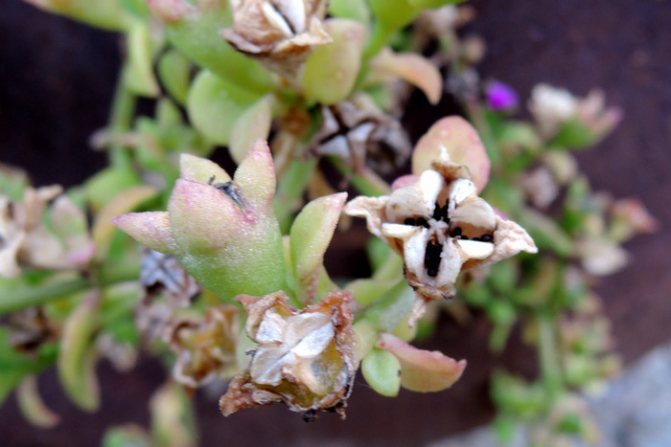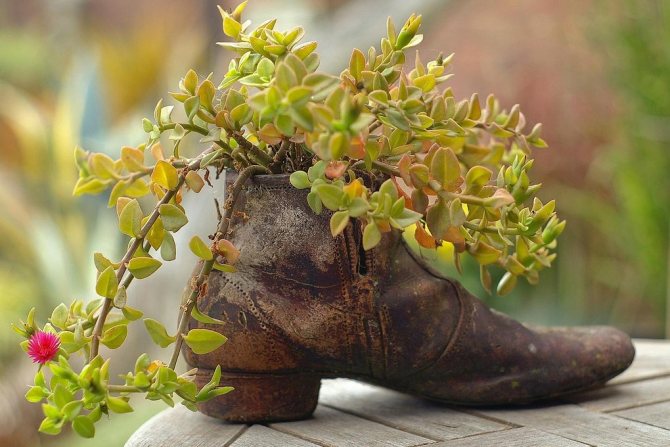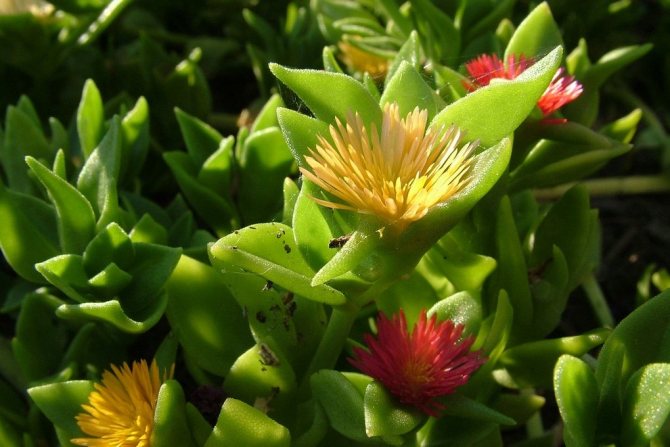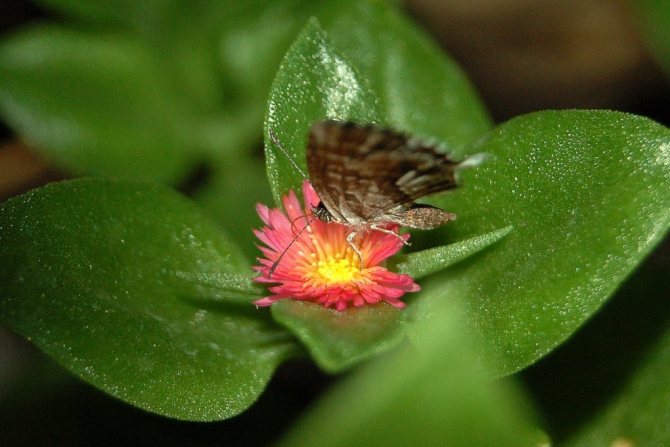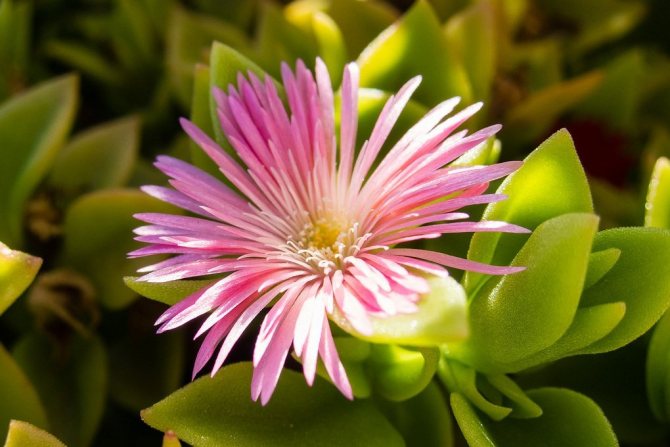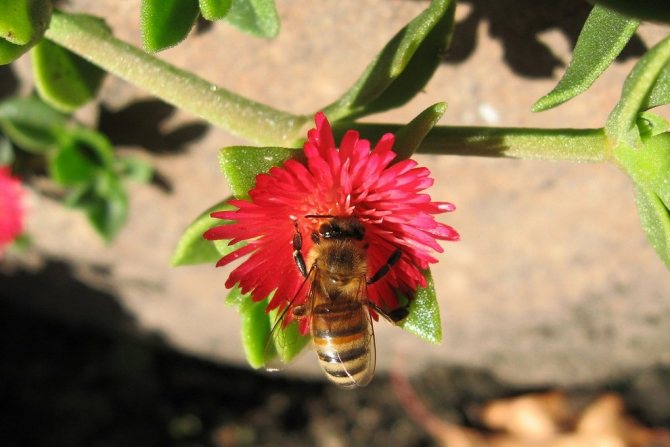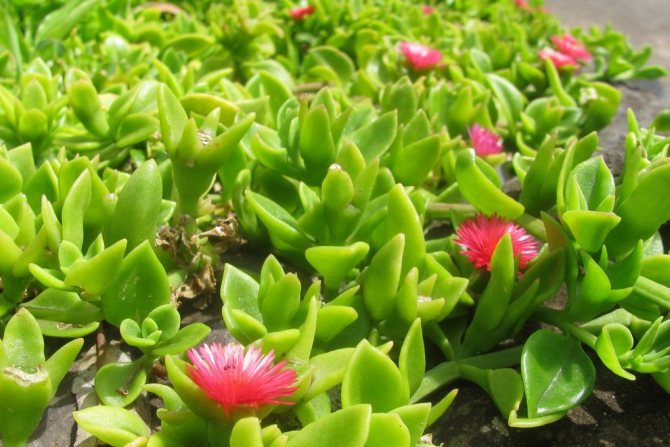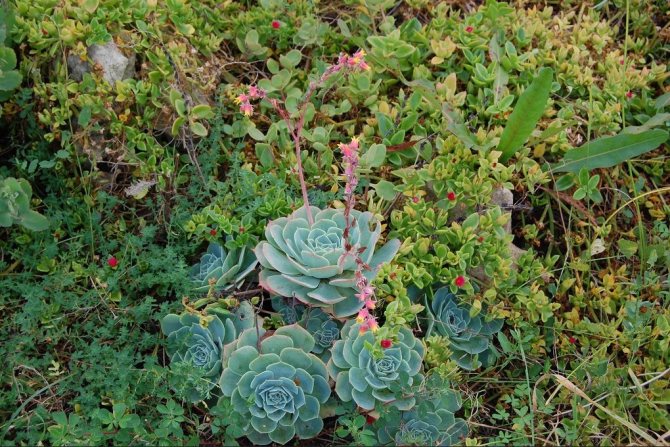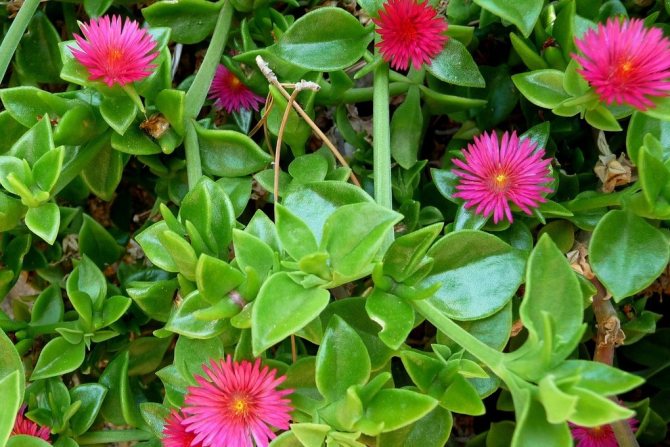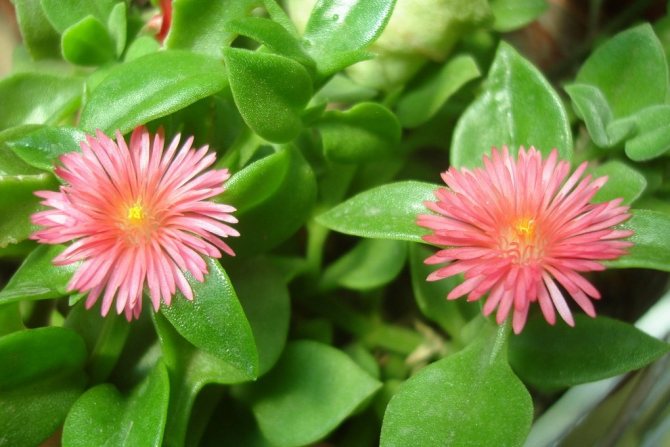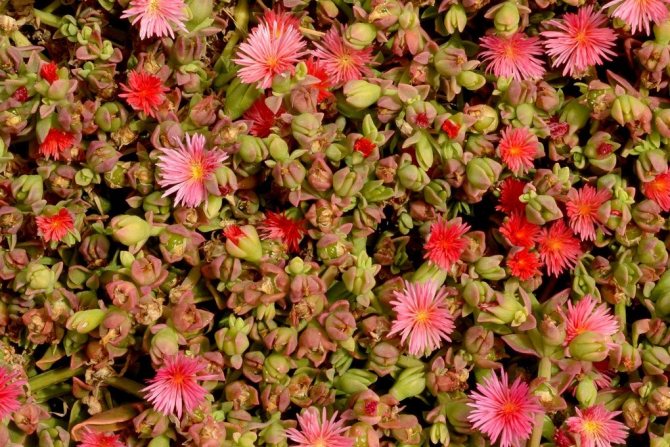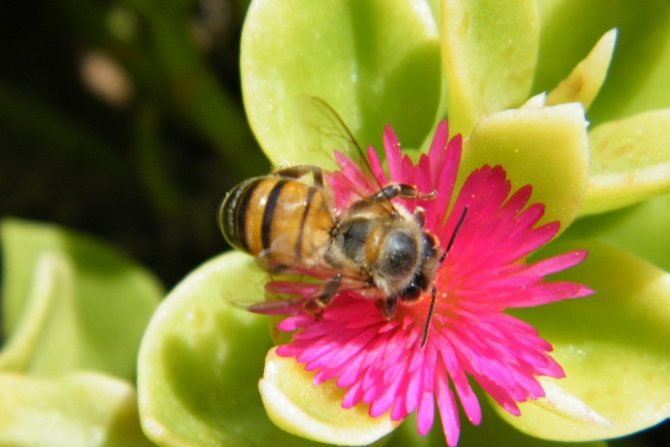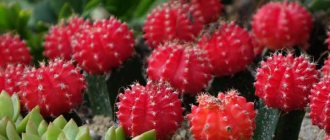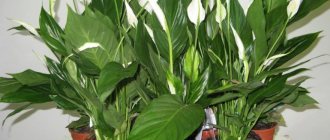The Aptenia plant literally translates as "wingless" or a flower that begins to open its petals at noon. This succulent belongs to the Aiz family.
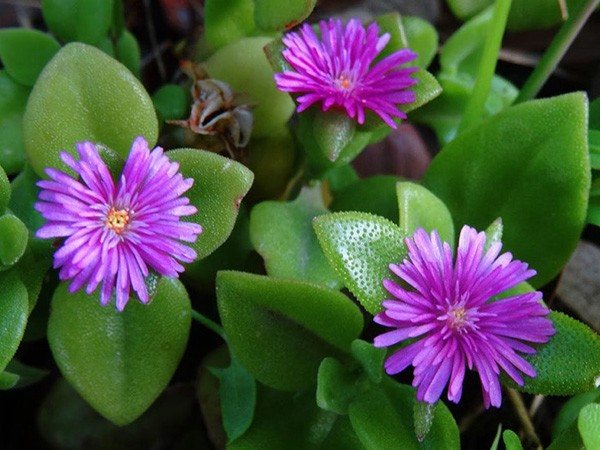
Aptenia has large fleshy shoots, its leaves are shaped like a heart. Inflorescences are small pink, red or blue, formed on lateral shoots.
Description of aptenia
Aptenia stems are fleshy, creeping, reaching a length of about 1 m. Dense, elastic leaves with papillae are arranged oppositely, heart-shaped or lanceolate in shape. Small flowers (up to 1.5 cm in diameter) appear in the axils of the leaves at the ends of the lateral branches. Needle petals, variegated color. After flowering, a fruit is formed, which is a capsule with chambers. Each chamber contains one large seed with a rough surface, the color is black-brown.
Thanks to creeping shoots, Aptenia is grown as an ampelous plant, in summer it can be planted in open ground as a ground cover plant.
Aptenia lanceolate
It differs from the previous specimens in the elongated shape of the leaves and longer lateral processes. Thin stems curl along the ground or hang down, reaching 1.5 m in length. Under natural conditions, the plant spreads along the ground, forming a continuous cover.
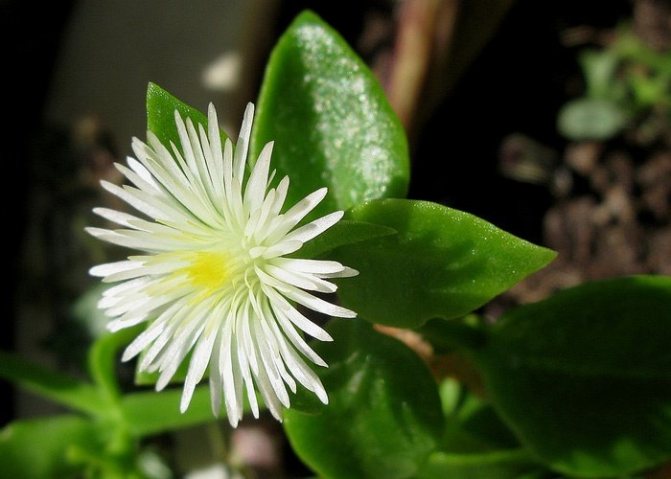

Small flowers delight the eye from April to October. The petals are of a delicate pink or lilac color with a silvery sheen.
Aptenia care at home
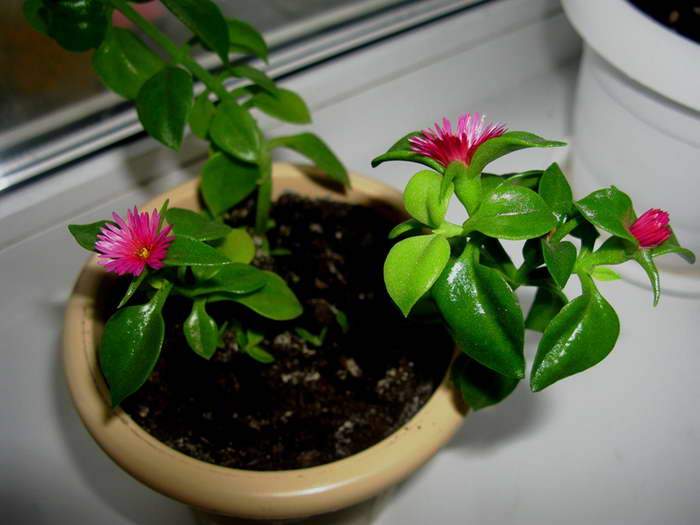

Aptenia heartfelt care at home photo
Lighting
The plant is light-loving. It is better to grow aptenia in the south-east or south-west windows. During especially hot lunch hours, it is recommended to shade the flower or ventilate the room. From a lack of light, the shoots will begin to stretch out and become bare, flowering will be scarce.
In the summer, take the aptenia out into the open air (in the garden, on the terrace, on the balcony), but gradually accustom it to direct sunlight. It can be planted in open ground as an annual in sunny areas - overheating will not occur from the natural flow of air. Aptenia looks especially beautiful on the alpine slides.
In the autumn-winter time, place in the most illuminated places (windows in the south-east and south-west direction).
Air temperature
In the spring and summer, keep the air temperature within 20-25 ° С, and in the fall and winter, reduce it to 8-10 ° С.
Winter period
If wintering is warm (21-25 ° С) shoots will begin to stretch out, leaves turn yellow and fall off, flowering will be worse or not at all. If you are unable to provide a cool temperature in winter, you need to provide additional illumination with fluorescent lamps (at least 50W).
Watering and humidity
Water the aptenia in moderation, excessive moisture without drying the soil leads to rotting of the root system. Water regularly in the spring and summer, reduce watering to a minimum in winter.
The plant tolerates dry air well, but do not place it in close proximity to heating systems that threaten overheating aptenia.
Top dressing
In the spring-summer period, a complex mineral fertilizer intended for succulents (fertilizer with a low nitrogen content) should be applied once a month.
Pruning
The plant tolerates formative pruning well. Spend it better in the fall.Spring pruning can lead to late flowering. If pruning is necessary (the shoots are bare in winter), postpone it until February at the most.
Transfer
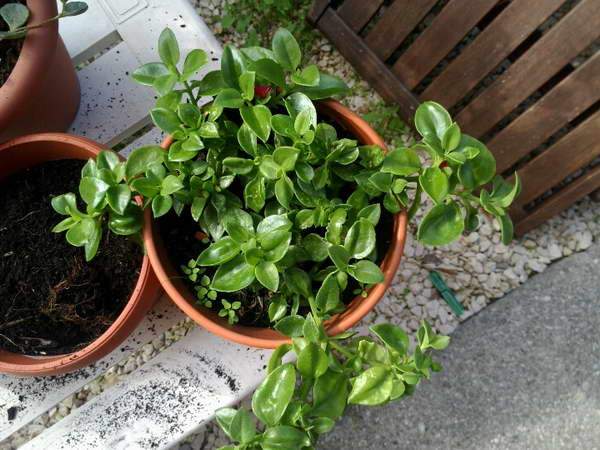

How to transplant aptenia photo
The roots of the plant are thick and powerful, filling the pot rather quickly. It should be replanted every year in the spring. Take a pot with a slightly larger diameter. The soil can be used standard for succulents. Lay a layer of drainage on the bottom, fill the pot by a third with soil, carefully remove the old pot from the earthen clod, freeing the plant.
It is advisable not to injure the roots by transferring from a smaller pot to a larger one. After transshipment, the voids are filled with soil. When transplanting, it is advisable to maintain the same level of the root collar, it is only allowed to slightly add the earth from above, no more than 2 cm.
Aptenia soil and first watering after transplanting
The plant is not demanding on the soil, but the presence of an admixture of sand is required.
Place a drainage layer at the bottom of the pot. Fill the rest of the place with a mixture of sand and sod land, or the following soil mixture: sod, leafy soil, humus and sand in proportions 1: 1: 1: 2. After transplanting, watering is not necessary immediately, but after about 3-4 days, so that the plant adapts a little and does not rot the roots.
Watering and humidity
The air can be dry, but not hot. Aptenia will appreciate the care in the form of spraying and washing the leaves, especially in the spring and summer. The soil in the planting container, while irrigating the plant, can be covered with polyethylene, and the pot can be tilted. All dust is easily washed off under running water. In autumn and winter, these treatments can harm aptenia.
Watering is necessary every time the topsoil dries up. The volume of water should be large, and the procedure itself should be regular in warm seasons, and rare in winter. Using tap water, it must first be cleaned of harmful impurities.
Fertilizers
Such a succulent as variegated aptenia and its other types, prefers regular feeding. Complex preparations should be introduced every 30 days from March to August. Use those where there is a low nitrogen content. By breaking an unshakable rule, you can prevent decay.
Transfer
Considering that the aptenia rhizome is a set of processes, thick and powerful enough. They are heavier than the plant itself and fill the flowerpot from the inside very quickly. As soon as this happens, you should start a transplant. On average, this happens once a year and better in the spring.
Cropping: frequency and need
To form the shoots of the mesembryanthemum, pruning should be carried out, which are given to the plant easily. Forming is best done in the fall. But in conditions where the succulents run bare during the winter, it is better to cut the branches no later than February.
Growing aptenia from seeds at home
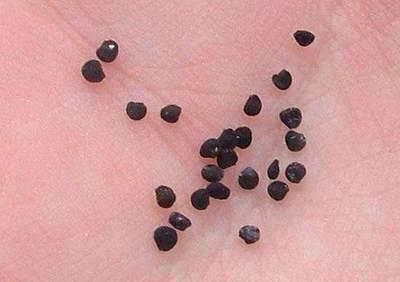

Aptenia seeds photo
Reproduction of aptenia occurs by seeds and cuttings.
- The seeds are sown in light sandy soil: containers with drainage holes in the bottom are prepared in advance, the soil mixture is poured, well leveled so that water does not accumulate in the holes later. Then they lightly press the earth with their palm so that it settles a little.
- Plant the seeds not deeply, no more than 1 cm. To get more accurate, you can make dimples in advance with a toothpick and carefully place the seeds there. The distance between seedlings in a common container is 3-4 cm.
- After sowing, moisten the substrate with a spray bottle and cover the container with a transparent lid or bag. Provide good lighting and a temperature of 21-24 ° C, ventilate the mini-greenhouse daily.
- Seedlings will appear quickly enough. Provide the emerging seedlings with bright lighting and an air temperature of at least 21 ° C. Water often, but as they grow, reduce watering and in no case allow water to stagnate.
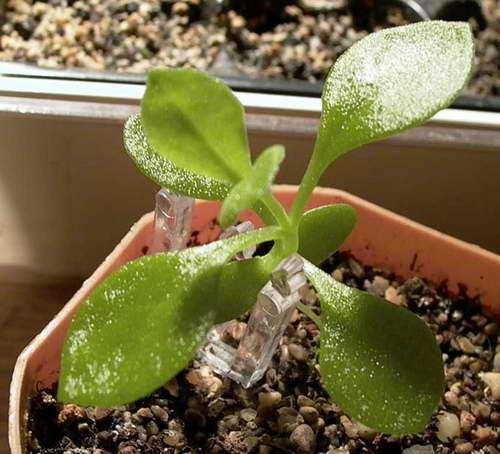

Aptenia from seeds photo of seedlings
- At the age of one month, it is necessary to pick the plants and plant them in separate pots with a diameter of about 5-7 cm. The composition of the soil: light turf and leafy soil, sand, everything is mixed in equal proportions. After transplanting, keep the pots with plants at a temperature of 16-18 ° C, water once a day.
When rooting occurs and new plants are actively growing, place them in a permanent place and care for them as adults.
Reproduction
There are several options for breeding aptenia. Let's get acquainted with each of them in more detail.
Seed method
In this case, surface sowing of seeds is used in a nutrient substrate consisting of light by the mechanical composition of soil or wet sand.
The seeds germinate quickly, but for this you need to provide favorable conditions - good lighting, as well as a temperature within 21-24 degrees.
Young plants watered with moderate amount of water, with constant intensive watering, rotting of the root system occurs.
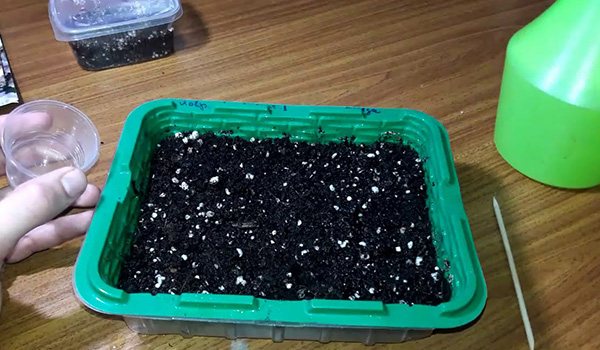

Cultures are transplanted into separate containers at the age of one month. For their normal development, nutritious a mixture of sod and leafy soil and sand... All of these components are mixed in equal proportions.
Flowers are installed in a shaded place where the temperature is maintained from 16 to 18 degrees. Watering plants is carried out every day, for this water at room temperature is used.
Cutting method
This video tells how to care for an interesting and unpretentious Aptenia plant and shows its reproduction by cuttings.
Vegetative parts that remain stored in a shaded dry room after trimming for 2-3 hours. After that, the vegetative organs are planted in containers with wet sand, as shown in the photo.
Important! For rooting, you can put the cuttings in water with the addition of coal. When the first roots appear, they are moved into separate containers, looked after, like the rest of the plants.
Propagation of aptenia by cuttings
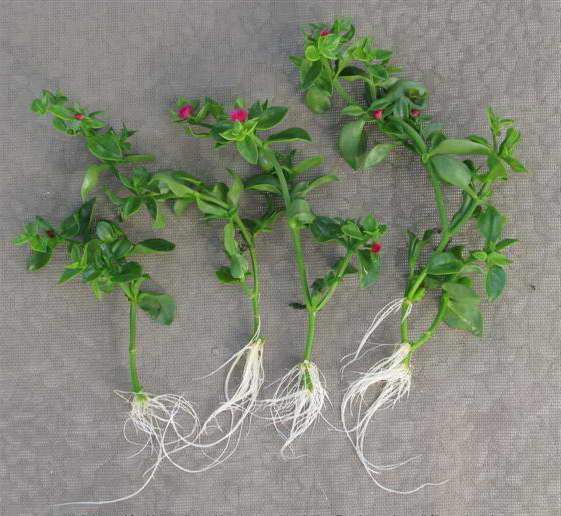

Aptenia propagation by cuttings photo
For reproduction, apical or leaf cuttings are used. You can root in wet sand, vermiculite, or mix succulent substrate with sand.
Aptenia perfectly gives root shoots in water. To improve the intensity of the process, regardless of the rooting method, it is advisable to hold the cuttings in a solution of root or heteroauxin for a day, and then plant them in the ground or put them in water.
Recommendations for planting and care of rooted plants are the same as for seedlings (diameter of the container, soil, watering, temperature).
Agrotechnics
Aptenia care is pretty straightforward. The difficulty level of growing is suitable for beginner growers.
- Lighting. Loves sunny places. It is not afraid of the open sun on the street or on the balcony; it is better to shade in an apartment in hot sunny weather. It is allowed to put on any windows except the north one. In the shade it withers, stretches, loses its decorative effect.
- Temperature. In the summer he loves warmth. Aptenia is kept at 22-25 ° C under average room temperatures. In winter, it is recommended to arrange a dormant period - transfer to a cool room 8-10 ° C. A glazed, insulated balcony will do. Keeping warm in winter requires artificial lighting.
- Humidity. Additional air humidification is not required. Dry air in the apartment does not harm the flower. But it is not recommended to put it next to batteries and heaters.
- Watering. Not frequent and careful. In winter, they are minimal. Wait until the substrate is completely dry. Regular waterlogging leads to the development of rot. With a prolonged absence of moisture, the leaves flabby and wrinkle.
- The soil. Suitable soils for succulents. It is prepared independently from turf and sand. They keep the same proportions. It is recommended to add baking powder - small pebbles, coconut flakes.
- Top dressing. Only mineral complexes for succulents are suitable as fertilizers. They are brought in no more than once a month. In winter, no additional food is required.
- Transfer. Transplanted when the root system becomes cramped in an old pot. The preferred time for transplanting is spring. Each time the pot is increased slightly. Drainage is poured onto the bottom without fail.
Advice! In summer, pots or pots with a flower are recommended to be taken outside or on a balcony. The place is chosen bright, sunny. Lack of sun leads to poor flowering, falling foliage, exposure and elongation of stems.
Types of aptenia with photos and descriptions
According to various sources, the genus Aptenia has from two to four species.
Aptenia cordifolia Aptenia cordifolia
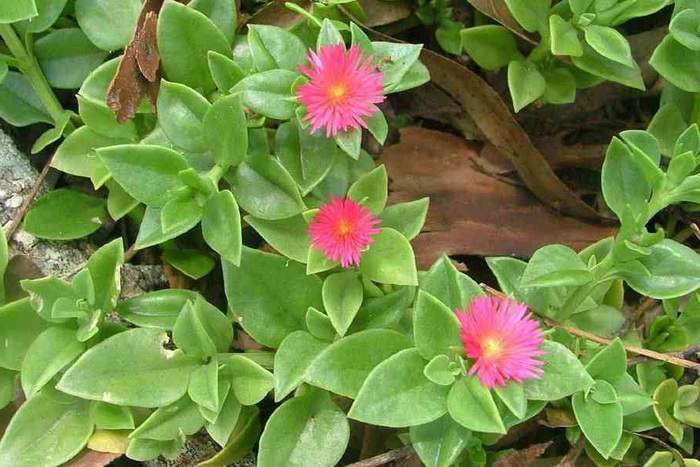

Aptenia cordifolia Aptenia cordifolia photo
Originally from South Africa. It is a perennial succulent that grows rapidly. Spreading creeping shoots reach lengths up to 60 cm, they are fleshy, oval or tetrahedral, have a gray-green color. Leaves are fleshy with papillae, heart-shaped or oblong, about 2.5 cm long, have a bright green color.
The flowers are multi-petaled, small (up to 1.5 cm in diameter), apical or axillary, single, painted in pink-lilac, crimson or bright purple shades. Flowers open before or after lunch. Only in bright light do they fully unfold. The flowering period begins in April and lasts until the end of summer.
In addition to decoration, this species is used as a medicinal plant.
Aptenia cordifolia variegated Aptenia cordifolia Variegata
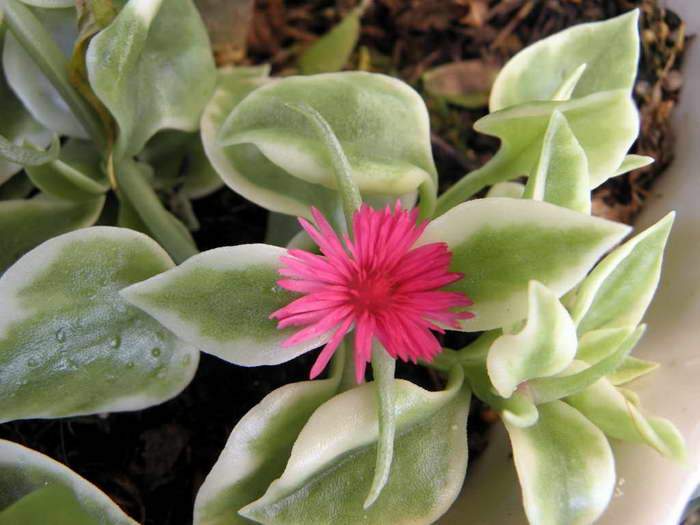

Aptenia cordifolia variegated Aptenia cordifolia Variegata photo
Variegated cultural form. Shoots and leaves are slightly smaller than those of Aptenia cordifolia. A lighter shade edging runs along the edges of the leaves. The color of the flowers is bright scarlet.
Aptenia lanceolate Aptenia lancifolia
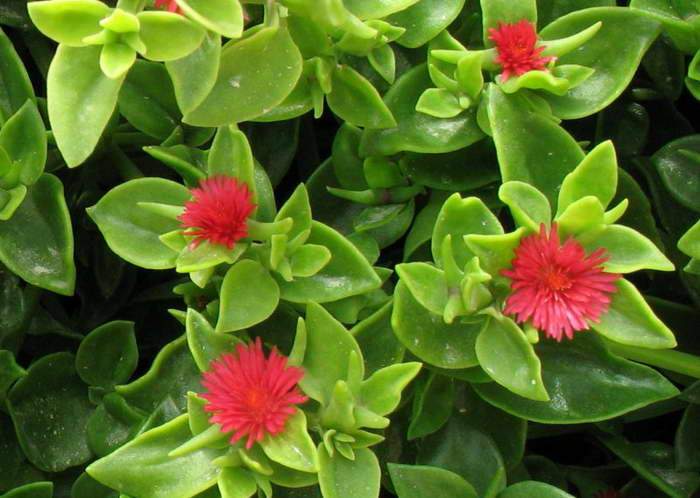

Aptenia lanceolate Aptenia lancifolia photo
Homeland is South Africa. A perennial succulent with spreading creeping shoots, reaching a length of 1.5 m. Shoots and leaves are dense, fleshy, covered with papillae. The leaves are lanceolate, opposite. Small flowers have a pale pink or lilac hue. Flowering lasts from April to October.


Aptenia (Aptenia) is an evergreen plant that belongs to succulents and belongs to the Aizov family. His homeland is considered to be Africa and the South of America. In science, succulent is known under two names of Greek origin: Aptenia is wingless, which reflects the peculiarity of the structure of its seeds. And the second name: mesembriantemum - a flower that opens at noon.
It is a creeping plant with fleshy shoots and succulent oval leaves. Aptenia looks very impressive during flowering, strewn with small, but surprisingly bright flowers of purple hues. Later, fruits are formed in their place: multi-chamber capsules. In each chamber of the capsule, one large dark seed with a rough shell ripens.
Among indoor plants, Aptenia cordifolia is most often found. This species is distinguished by an oval or ribbed shape of fleshy gray-green shoots. They are attached to oppositely located bright green leaves of a lanceolate or heart-shaped shape. Heart-leaved aptenia blooms with single apical and axillary flowers of bright purple, lilac or pink shades.
Flowering time
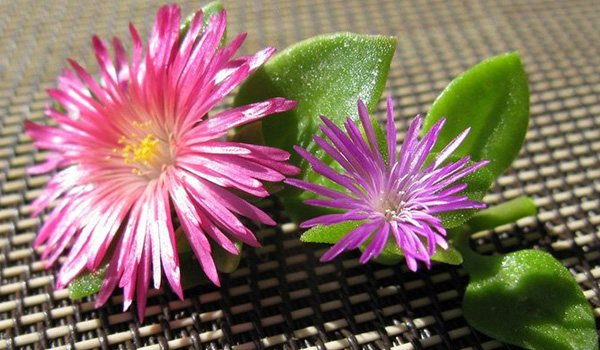

Flowering culture is observed throughout the warm period of the year from April to the end of August.
Inflorescences appear at lunchtime, but flowers do not always open fully, for this you need good, bright lighting.
Important! In winter, the plant goes into a dormant state to gain strength.
Aptenia care at home
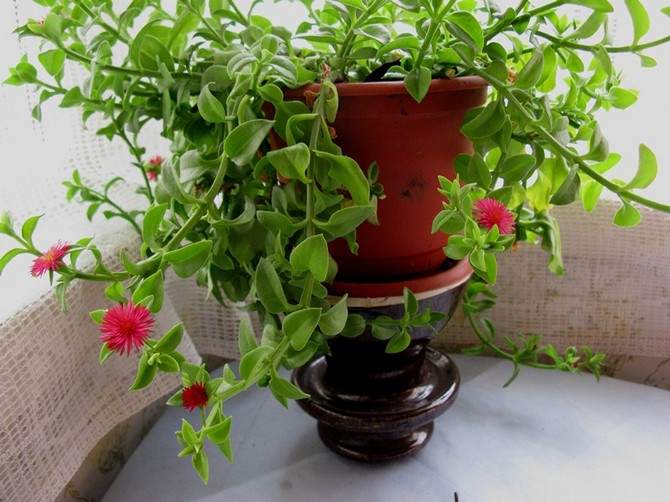

Location and lighting
In summer, the aptenia will be more comfortable outdoors and in a sunny place.In indoor conditions in the summer they darken it, protecting it from direct sunlight. No shading is required in autumn and winter.
Temperature
From spring to autumn, during the active growing season, aptenia needs maintenance at a temperature of 22-25 degrees. But in winter she prefers coolness: the temperature should be no higher than 8-10 degrees. If you cannot provide her with a cool wintering, then please at least with additional lighting.
Air humidity
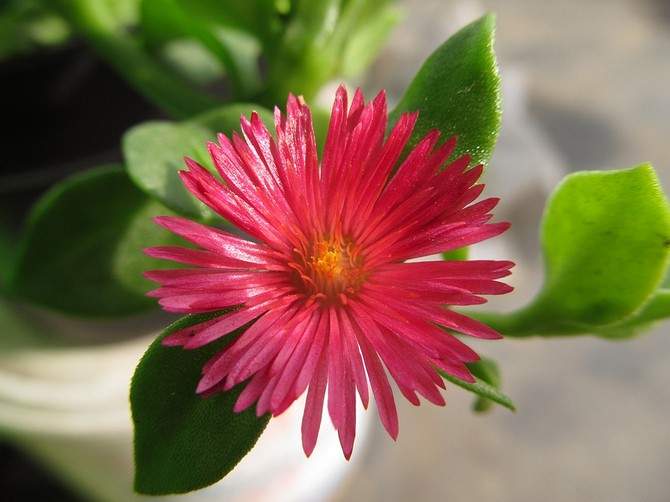

Aptenia is one of the few plants that can be easily grown in dry indoor air. The plant does not need additional moisture. But in winter, you should not place the aptenia near batteries and heating appliances.
Watering
In spring and summer, the plant is watered moderately, in winter - rarely. The frequency of watering is determined by the complete drying of the soil in the pot. With a lack of moisture, the succulent leaves begin to wrinkle.
The soil
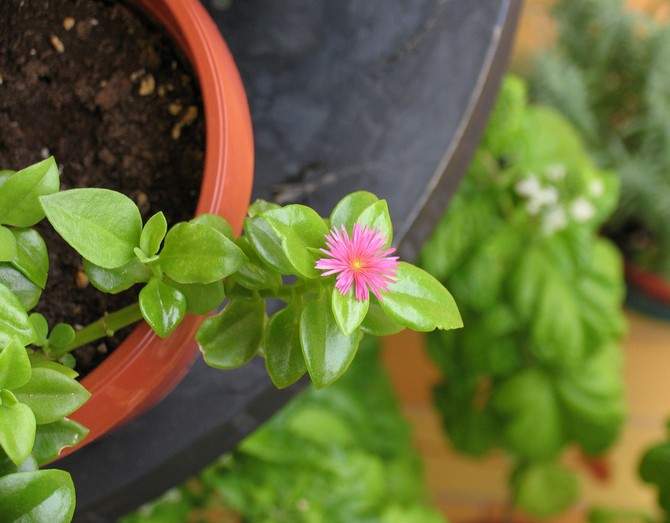

The optimal composition of the soil for growing Aptenia: turf soil and sand in equal amounts. You can also use ready-made potting mix for cacti and succulents.
Top dressing and fertilizers
Aptenia is fertilized from spring to late autumn once a month, using complex fertilizers for cacti and succulents.
Pruning
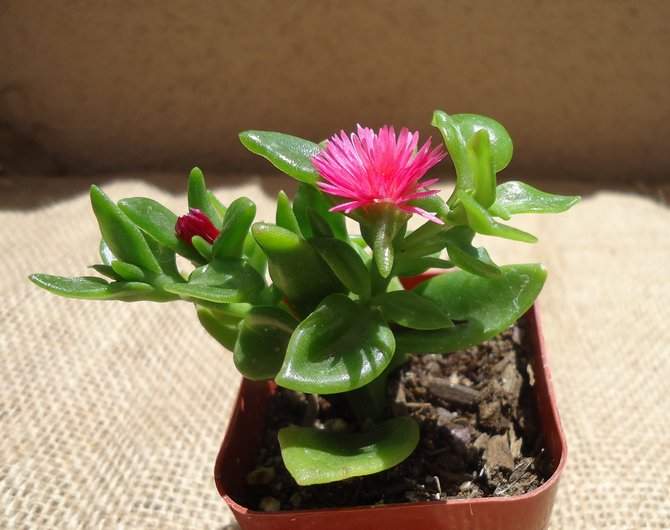

To make aptenia decorative, it is necessary to carry out formative pruning. This procedure is best done in the fall due to the summer flowering of the succulent.
Transfer
Aptenia grows quickly enough and a moment comes when it becomes cramped and the root system completely fills the pot. This affects her appearance. It is also a signal to the need for a transplant. It is better to transplant in the spring, having prepared a larger pot. A good drainage layer must be placed at the bottom of the pot.
Growing rules
Each problem that arises with a young aptenia is a litmus test of the care provided for the plant:
- If foliage falls, this indicates waterlogging or drought on the soil mixture;
- Falling leaves in autumn or winter indicate an elevated room temperature. Simple transportation to a more suitable location can save the plant;
- If there is no flowering, it means that the winter conditions were too "greenhouse", and the lighting was not enough.
Watering and lighting are the main actions that will ensure the health and powerful flowering of aptenia.
Reproduction of aptenia
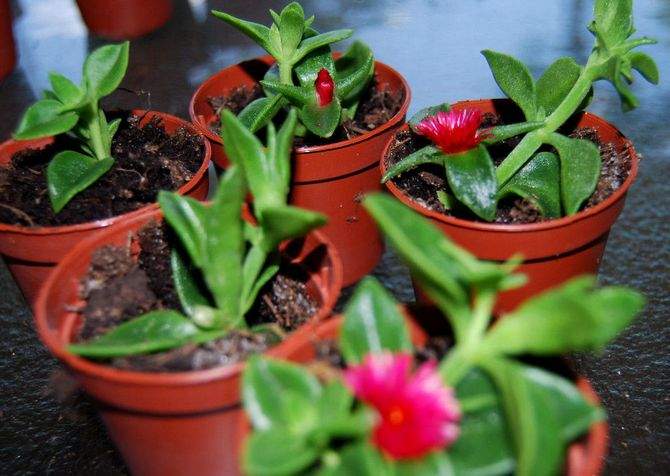

Aptenia is usually propagated by seeds and cuttings.
Reproduction using stem cuttings is quite easy and simple. Cuttings are separated from an adult healthy plant by drying in a dark and dry room for several hours. Dried cuttings are rooted using wet sand, a mixture of light soil and sand, or just water.
Reproduction of aptenia by seeds takes more time and effort. To begin with, the seeds are distributed on the surface of the sandy substrate, sprinkling on top. Seedlings will appear quickly. As soon as this happens, the container is transferred to a well-lit and warm place with an air temperature of at least 21 degrees. Seedlings are watered very carefully, trying to avoid waterlogging, which is fraught with rot. A month later, a pick is carried out, placing young plants in small single pots.
Planting and breeding methods
Aptenia reproduces in two ways - by seeds and cuttings. Each method has its own characteristics.
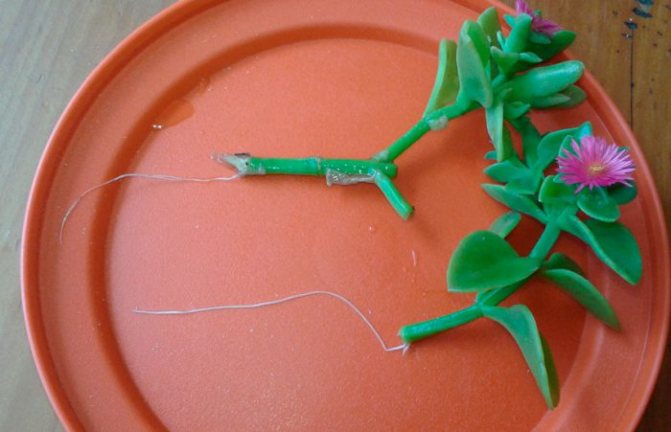

Can be propagated by seed or cuttings
Seed reproduction
Sowing is carried out in the spring. The seeds are sown directly on top of the sand or soil; no deepening is required. The sprouts appear pretty quickly. As soon as they grow, the box with seedlings is transferred to a more lighted place and the air temperature is maintained at +21 degrees.
Young sprouts need to be watered regularly, but you need to be as careful as possible. It is important to prevent excess moisture, otherwise the stems will begin to rot.After a month, the seedlings can be distributed in separate pots.
Cuttings
Propagation by cuttings is an easier and faster way. Shoots are cut from the tops, placed in water for the emergence of roots. In addition to water, you can keep the cuttings in the sand. The main thing is that it is moist enough for the growth of the root system.
RECOMMENDATION! (click to find out)
For water rooting, it is recommended to add some activated carbon. This will help prevent stem rot.
As soon as several strong roots are formed on the cuttings, you can safely transplant them into the ground. To do this, prepare a container with a diameter of at least 5 cm.
Thus, aptenia is an evergreen plant, characterized by fleshy petals and beautiful flowers that bloom only under good light. Culture requires strict adherence to all the rules of home care.
Aptenia - planting and care (video)
An evergreen plant like aptenia (Aptenia) is a succulent and is directly related to the family Aizoaceae or Mesembryanthemaceae. This plant comes from Africa and South America.
The plant got its name from aptenia because of its wingless seeds, so “apten”, if translated from Greek, means “wingless”. This plant is also called mesembriantemum, which when translated from Greek means "mesembria" - "noon" and "anthemom" - "flower". This name is due to the fact that the flowers of the plant bloom precisely at noon.
Such an evergreen succulent has creeping fleshy stems, on which fleshy heart-shaped leaves are located opposite. Small red flowers are located at the ends of the lateral branches in the leaf axils. The fruit is a capsule with chambers. Each chamber contains 1 brownish-black seed of a rather large size, the surface of which is rough.
General information
The name Aptenia was given to the plant because of the wingless seeds, the word "apten" is translated from Greek as "wingless". Another name - mesembriantemum from Greek is translated as a flower that opens at noon.
Aptenia is an evergreen, succulent plant, it has fleshy but fragile, creeping shoots, opposite dense and juicy leaves in the shape of a heart. The flowers are small, but bright - red, blue or pink, grow on lateral shoots, in the leaf axils. After flowering, a capsule appears in their place with a single black-brown seed.
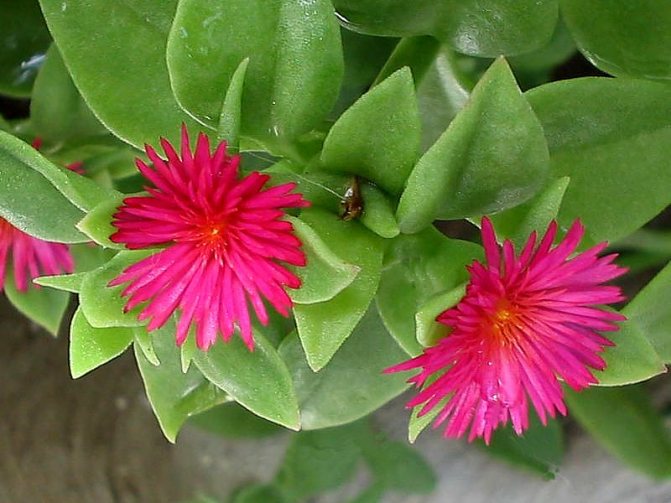

Aptenia.
Aptenia blooms from April to late autumn, in winter it needs a rest period to recuperate.
Most often, three types of aptenia are grown at home, these are cordial aptenia, lanceolate aptenia and variegated aptenia. These are indoor flowers, and annual garden plants, convenient for growing on alpine slides, and ampelous plants for growing in hanging flowerpots.
Aptenia cordifolia has small flowers of pink, raspberry, bright red or lilac-pink color, opposite fleshy leaves, creeping shoots.
Aptenia lanceolate differs in that the surface of its lanceolate leaves is rough, dark green. Shoots are long - up to 80 cm, flowers are multi-petal, small, red or bright purple. Flowers are fully revealed only in bright light.
Aptenia variegated differs in smaller leaves, shoots and flowers. But its most important difference is leaf spot. Variegated plants differ from ordinary ones in that, along with ordinary cells, they have mutant cells that are not capable of photosynthesis and the production of chlorophyll. Therefore, the leaves of variegated plants have a lighter color, with a pattern of spots and specks, which can have any shape. The spots can be randomly or orderly.
The term "variegated" from English is translated as "variegated", "multi-colored", "spotted". In nature, there is a whole group of variegated plants, which includes aptenia.
Botanists call variegated plants biological chimeras and warn that caring for them is more difficult than for plants with normal genetics, since chlorophyll-free cells exist at the expense of normal cells.
Aptenia care at home
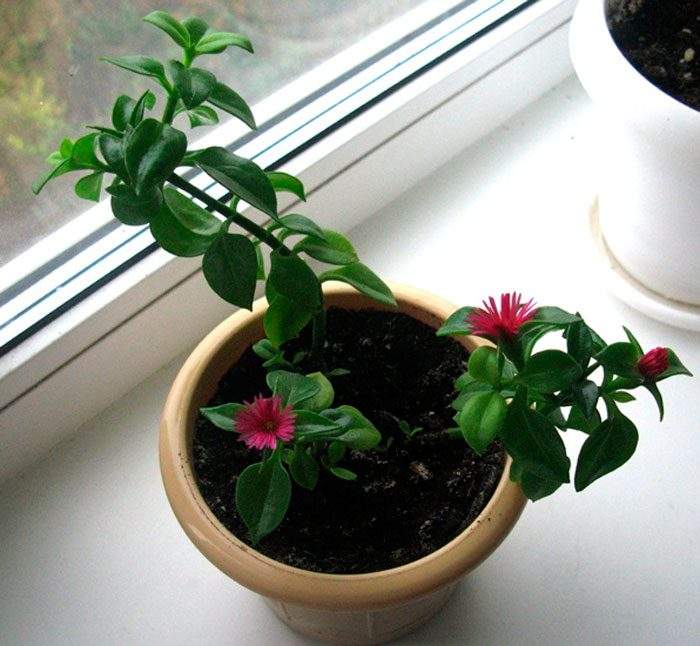

Illumination
This plant loves light. In the summertime, it is recommended to move it outdoors, where it feels great in direct sunlight. If in the summer the flower is in the house, then it must be protected from the direct midday rays of the sun. It is not necessary to shade in autumn and winter.
Temperature regime
In the warm season, it is recommended to keep the air temperature at the level of 22-25 degrees. The flower should overwinter in a cool (from 8 to 10 degrees) place. With a warm winter, the plant will need additional lighting.
Air humidity
Such a plant does not need high humidity, and it feels quite comfortable in the dry air inherent in city apartments. However, in the cold season, it must be kept away from heating appliances.
How to water
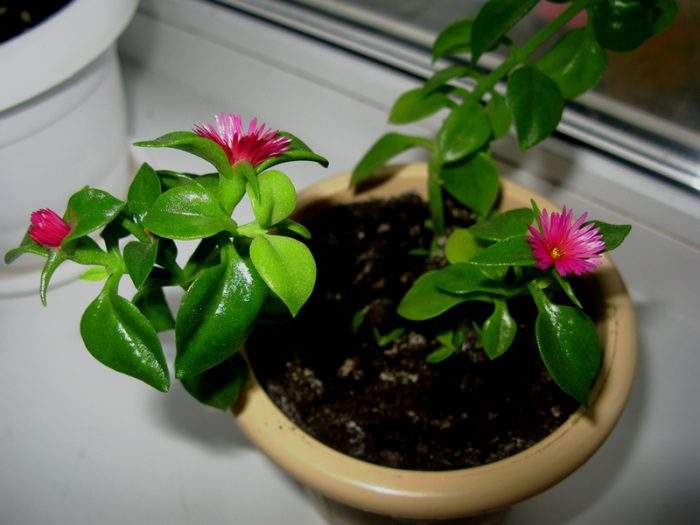

In the spring and summer, watering such a plant should be moderate. Watering should be done only after the potted substrate has dried to the very bottom. In winter, watering is extremely rare, but at the same time they do not allow wrinkling of the leaf plates.
Top dressing
In spring and summer, the aptenia needs to be fed once every 4 weeks. To do this, use a complex fertilizer for cacti and succulent plants. In winter, fertilizers are not applied to the soil.
Pruning
Such a plant needs formative pruning and is recommended to be carried out in the autumn. The fact is that due to the pruning carried out in the spring, flowering occurs somewhat later.
Transplant features
The transplant is carried out in the spring and only after the root system ceases to be placed in the container. A suitable dredge consists of sand and turf soil (1: 1). Purchased soil for succulent plants and cacti is suitable for planting. Don't forget to make a good drainage layer at the bottom of the container
Reproduction methods
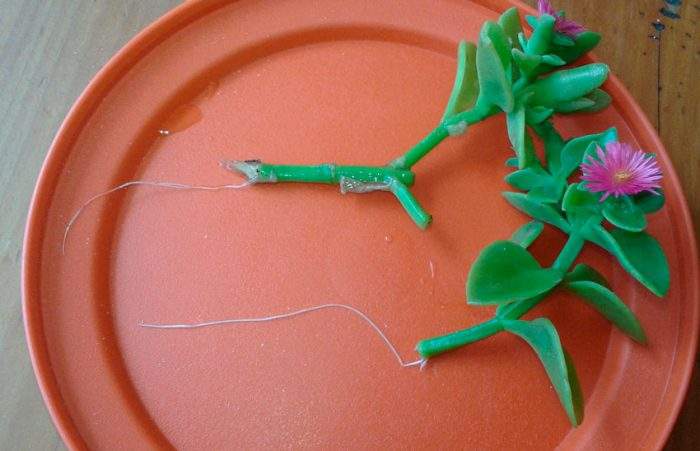

Can be propagated by seed or cuttings.
Sowing seeds is carried out on top of sand or sand mixed with light soil (do not deepen). The seedlings will appear soon enough. After that, the container with the seedlings is moved to a bright place where the temperature does not drop below 21 degrees. Watering is extremely careful, as the seedlings can easily rot. After 1 month after the emergence of seedlings, the first pick should be carried out. In the process of growth, young plants are transplanted into individual pots with a diameter of 5 to 7 centimeters.
Before planting the cuttings, they are left in a dry, dark place for several hours to dry. For rooting, you can use vermiculite, moistened sand, or sand mixed with purchased soil for succulents. A glass of water is also suitable for this purpose, but a small amount of activated carbon should be added to it. After rooting, the plants are transplanted into separate pots with a diameter of 5 to 7 centimeters.
Pests and diseases
It is quite resistant to pests and various diseases.
It usually gets sick as a result of improper care:
- Falling foliage - overdrying of an earthen coma or stagnation of liquid has occurred in the soil. The plant hibernates in the warmth.
- Lack of flowering - warm wintering, little light.
- The appearance of rot - overflow, oversaturation of the soil with nitrogen.
Diseases and pests
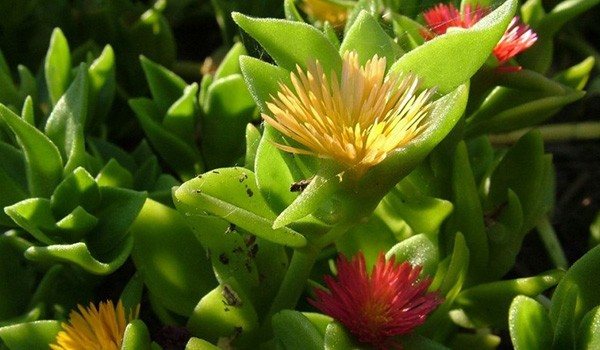

Aptenia resists the effects of various diseases well, it is not damaged by pests. Problems with flower development arise through improper care.
So, the reason for the fall of leaves on the crop is improper watering (overdrying of the earth or stagnation of moisture in the pot), as well as wintering the plant in a warm room.
Lack of flowering occurs through a lack of natural light or in the absence of a dormant period for the plant. Follow the rules for caring for aptenia and you will get a beautiful lush flower with a huge number of inflorescences.
Main types
Aptenia cordifolia (Aptenia cordifolia)
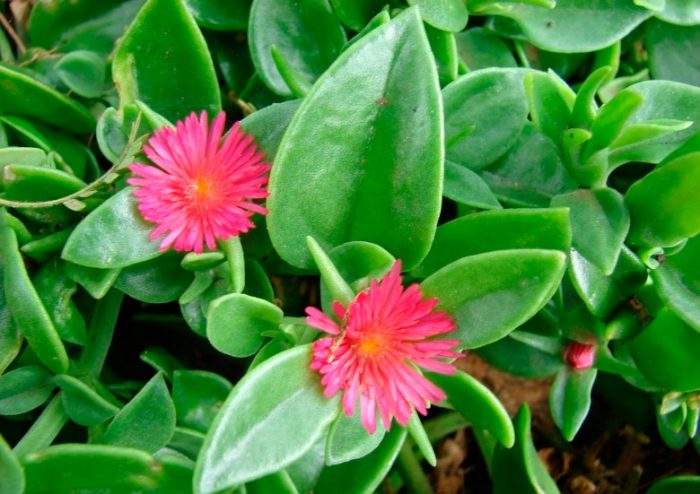

Or mesembryanthemum cordifolium - this evergreen plant is a perennial and grows relatively quickly. The spreading stems are creeping. The greenish-gray fleshy stems have an oval or tetrahedral sectional shape. The rich green, oppositely located fleshy leaves have a heart-lanceolate shape, and they do not exceed 2.5 centimeters in length. Small, single, multi-petal flowers can be either axillary or apical. They can be colored lilac-pink, deep purple or crimson.
Variegated Aptenia (Aptenia Variegata)
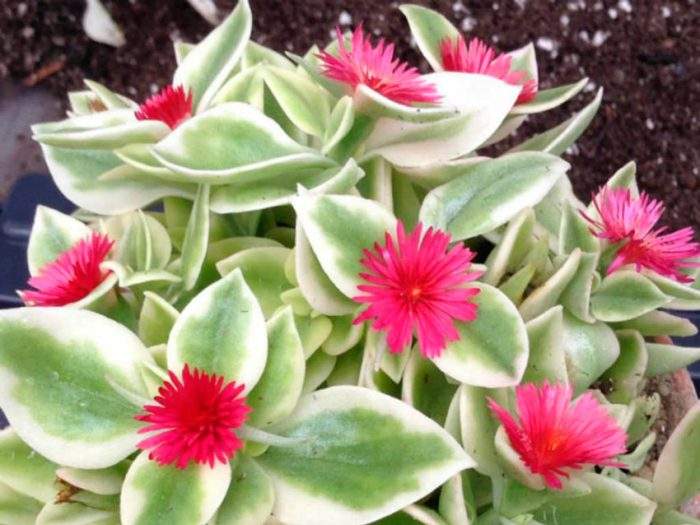

Compared to cordifolia aptenia, it has smaller shoots and leaves; this is a cultivated variegated form of aptenia.
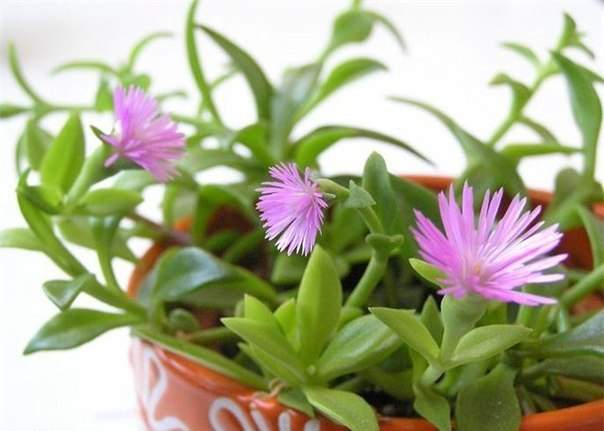

Aptenia still quite a rare flower on our windowsills.
This interesting plant attracts the attention of tourists in North African resorts and often comes illegally to Russia in bags and suitcases in the company of shells and pebbles.
The plant took its name from its seeds. They have no wings, and the word apten is translated from Greek as wingless. Its fruit is a capsule with chambers, each with a large seed ripens. It also has a name - mesembriantemum, which translates as a midday flower.
Difficulties of growing
The flower is considered resistant to diseases and pests. The main problem is the development of rot as a result of excessive watering. In rare cases, it can become infected with spider mites or mealybugs from neighboring plants. The rest of the problems are caused by inaccuracies in care and can be easily eliminated by adjusting the conditions of detention.
| Falling leaves | Probable reasons are warm wintering, excessive or insufficient watering. | It is recommended to keep the plant cool in winter. Watering only after the soil has completely dried out, but do not allow a long absence of watering. |
| Little or no bloom | Lack of light, late pruning, warm wintering. | Formative pruning is carried out in early spring before active growth begins. Choose the most illuminated place in the apartment. |
| Decay of stems or roots | Frequent watering, poor drainage, high nitrogen content in the soil, cold in summer. | Drainage should take up to a third of the pot, feeding is carried out only with mineral complexes for succulents. When decaying, the plant is recommended to be transplanted into fresh soil. |
Looking at the photo of aptenia, you will understand what caused the interest of flower growers in this flower. A beautiful, original, unpretentious plant looks equally good in compositions or on its own as an ampelous culture.
The main types of aptenia
- Aptenia cordifolia (Aptenia cordifolia) - it is characterized by rapid growth, its shoots are gray-green, the leaves are lanceolate, fleshy, they are bright green, grow two and a half centimeters in height; flowers develop in the axils or at the tops, they are small, pink, purple and crimson;
- aptenia variegated (Aptenia Variegata) - in comparison with cordifolia aptenia, it has smaller shoots and leaves, this is a cultural variegated form of aptenia.
Aptenia variegata or variegated
Similar to the previous one, but its leaves are smaller, lanceolate or heart-shaped. It features a yellow or white border with a gradient transition to light green along the central vein. The flowers are brighter, often scarlet.
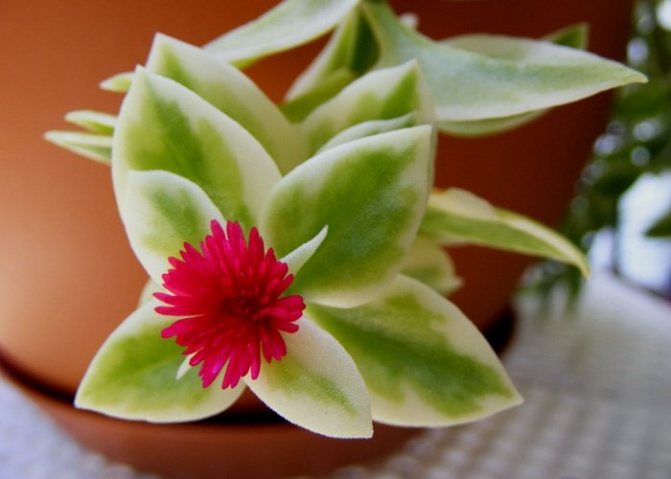

The fleshy leaves of the perennial are used to store moisture in case of drought. Therefore, with frequent watering, they are denser and thicker, and with a lack of water, they become thinner.
Home care
Lighting
Plant very light-lovingif he lacks lighting, it stretches out, the shoots become naked. The best place for him is windows with a southern orientation: southeast and southwest.
In summer, it is useful to take Aptenia outside, but it is gradually taught to direct rays, first covering it from the midday sun.
In winter, you should not cover it even on the southern windows.
Temperature
Optimum temperature air for aptenia in spring and summer 22-25 degrees. During the rest period, 8-10 degrees.
Hoya Karnosa. Read about this beautiful plant in our next article.
Hoya Multiflora. Home care and reproduction. Photo and video.
Watering
In spring and summer the plant is watered when the soil is completely dry, trying to do this in the system, for example, three times a week.
Aptenia is better to water less than pour. With an excess of water, its shoots rot.
During the rest period watering is noticeably reduced and watered no more than once a week so that the leaves do not wrinkle.
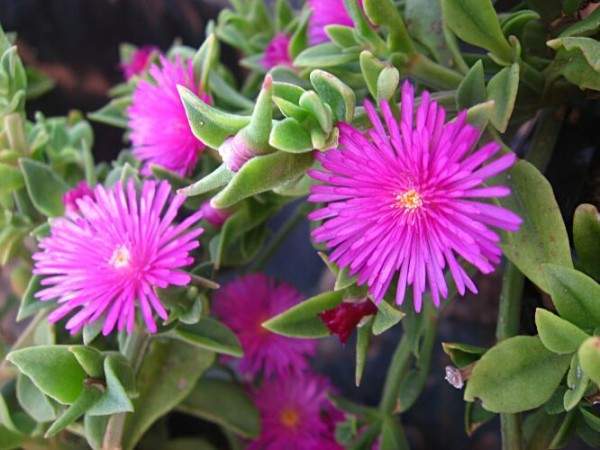

Air humidity
The dry air of aptenia is not terrible, but the whole problem is that it does not tolerate warm dry air from batteries.
In spring, the plant can be washed and sprayed, thus making it easier for it to exist next to heating devices, but in the autumn-winter period this cannot be done, therefore the plant must be placed as far away from them as possible.
Top dressing
Fertilize aptenia only In spring and summer, this is done once a month with special complex fertilizers for succulents. But you need to choose fertilizers that do not contain nitrogen, it is possible with a small content.
The soil
The best soil option for aptenia there will be a mixture consisting of turf and sand in equal proportions. Another option is also suitable: leaf, sod land, humus, sand in the following proportions: 1: 1: 1: 2.
Aptenia is not demanding on the soil, although she likes sand in the soil.
Dormant period
Late October and around mid-March the plant needs to organize a dormant period. At this time, the temperature should be no more than 8-10 degrees. If during this period you cannot withstand such a regime, the leaves will begin to fall off, the plant may not bloom.
If it is impossible to arrange a cold winter for the plant, it is necessary to give it the opportunity to develop during this period, and for this aptenia needs additional light, and it is better to place the plant under fluorescent lamps.
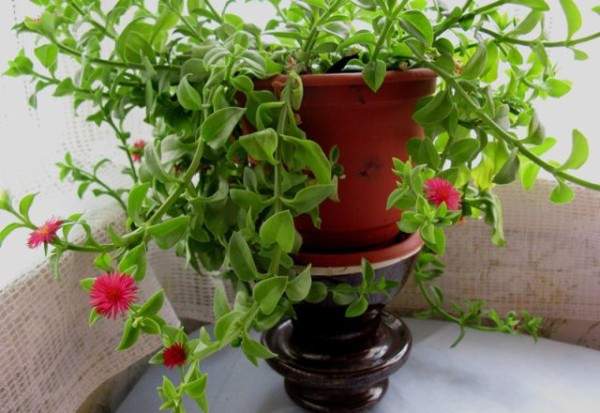

Pruning
Aptenia loves pruning. This procedure better to produce in autumnto give her the opportunity to overgrow with new shoots and lay buds for timely flowering. But if during the fall and winter the plant bared the shoots, then pruning can be carried out at the end of winter in February.
If necessary, cut off shoots are rooted, if this is done in autumn, then young aptenias will bloom in late spring.
Transfer
Aptenia has thick and too powerful roots for such a miniature plant, they fill the pot quickly enough, and as this is done, it is transplanted about once a yearbetter in spring. The pot is taken a little larger.
Delosperm flower. Read about this beautiful plant here.
And this article talks about the jatropha plant. Lighting, watering, soil, breeding and more.
Reproduction
The plant is propagated seeds and cuttings.
Seeds laid out on a soft substrate and, without falling asleep with earth, left in the light. You can put the seed bowl in a plastic bag or cover it with glass. The optimum temperature for germination is 21-25 degrees. Shoots appear quickly and need good lighting. The bag and glass are removed immediately after germination, otherwise the seedlings may rot.
Seeds are watered abundantly before germination, but this must be done carefully.After the seeds sprout, watering is gradually reduced. The seedlings are prone to rot during the first weeks.
A month after germination, the plants dive for the first time. They are planted in separate pots when the shoots reach a size of 5-7 centimeters in height.
For about a month, pots with young plants are kept in a cool place at a temperature of no higher than 18 degrees and watered daily.
With the second breeding method, cuttings, cut the stems and dry for 10-12 hours. Then they are planted in wet sand or vermiculite.
Cuttings root well in water, but it is imperative to add charcoal there. When the roots appear, the cuttings are planted in small containers, about 5-7 cm in diameter. Aptenia can be propagated by leaves according to the same principle as by cuttings.
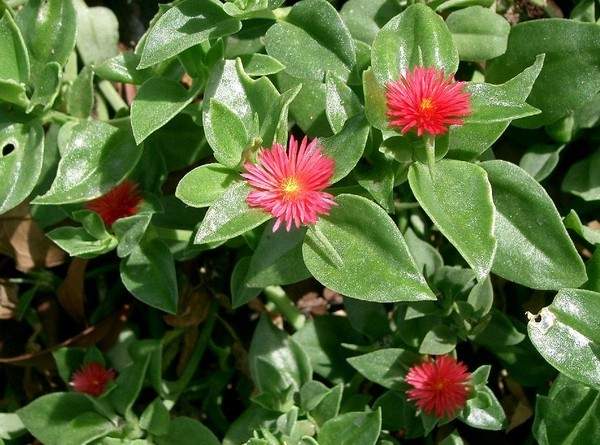

Pests and diseases
Aptenia practically not susceptible to disease... The only thing that can threaten her is different types of rot.
Like any groundcover, Aptenia can be grown in pots, next to tall, long-stemmed plants. But flower growers love to grow it in fairly wide shallow flowerpots as an ampelous plant.
Reproduction of the mesembryanthemum: tips and rules
The flower reproduces in only 2 ways:
- sowing seeds;
- by cuttings.
Seed method
Sowing seeds should be superficial. The substrate is a mixture of coarse sand and light soil in equal proportions. If there is no second component, you can do without it. The container for growing should be covered with glass or ordinary film, preferably food.
Having installed the container in a warm (within plus 21-25 degrees Celsius) and sunny place, you should wait for the sprouts. They germinate quickly. The shelter is immediately removed. Moisture collecting underneath and over-watering can lead to rotting. From this time on, the mesembriantemum is accustomed to less watering.
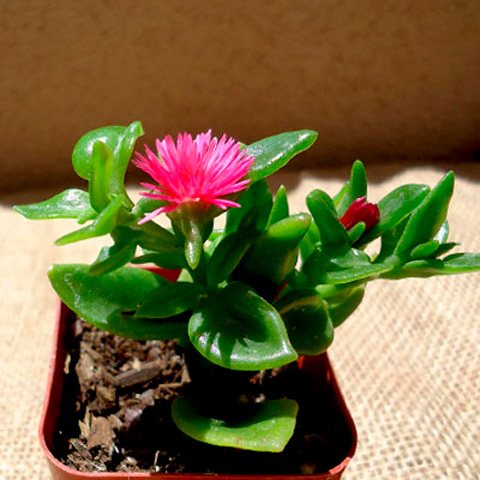

The pick is carried out one month after sowing. The sprouts during this period should reach 5-6 centimeters in height. It is better that each aptenia has its own pot.
The substrate in them should consist in equal parts of the following components:
- turf (better than light);
- river sand;
- sheet soil.
For growing young succulents, the temperature should be maintained within plus 16 - 18 degrees Celsius. Moisten the earth once a day.
Cutting or propagation by sheets
The landing part for this breeding method should not only be cut off, but also dried for up to 12 hours. River sand is an invariable component for the soil mixture of Aptenia. It should also contain vermiculite.
If you have to grow new plants from cuttings, then you should wait for centimeter root processes. They appear most quickly in boiled water, provided that activated carbon is dissolved in it. The most acceptable diameter of pots for growing this plant is from 5 to 8 cm.
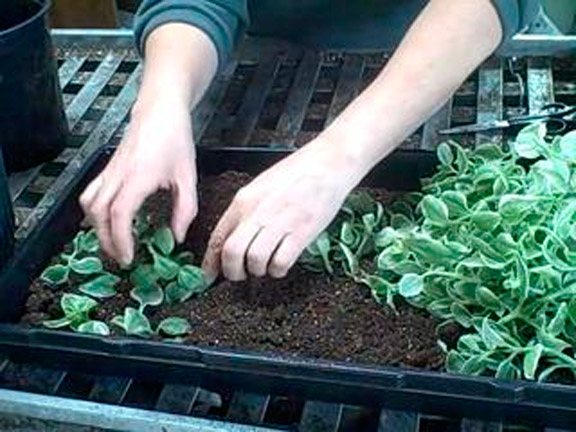

Lighting
It is better to gradually accustom the succulent to direct sunlight, although Aptenia feels good in direct sunlight, so in summer you can put the plant outside.
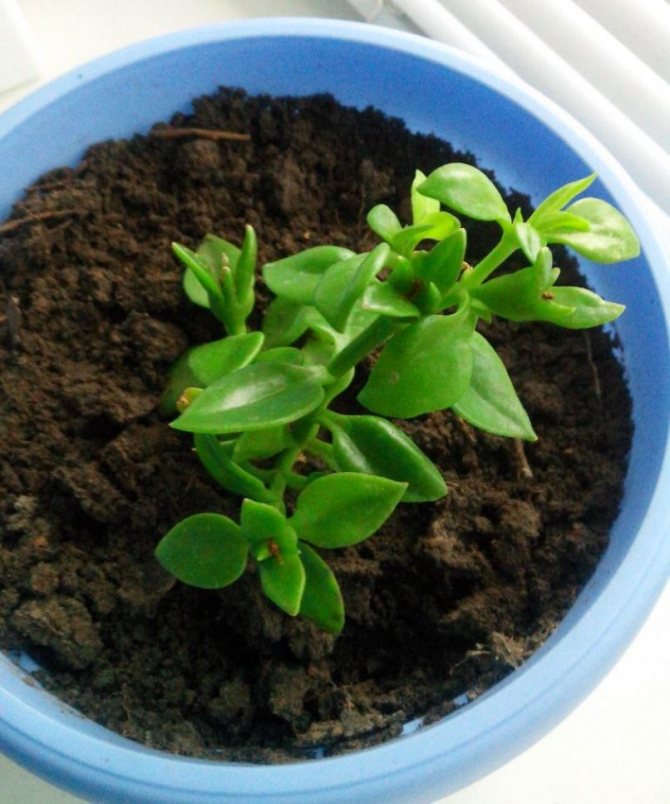

If you decide to leave the plant at home, then windows facing west and east are suitable for this. On the south side, the aptenia may get burns, and on the north there will be insufficient light.
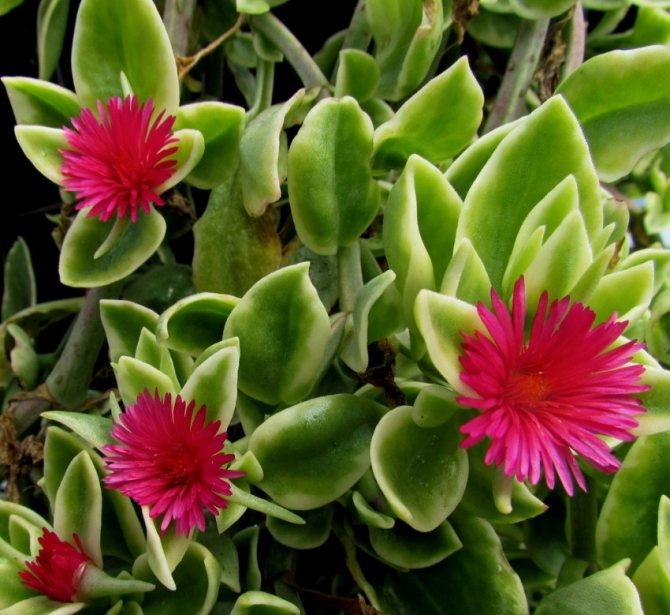

Conditions of detention: table by seasons
| Season | Lighting | Optimal temperature conditions | Air humidity |
| Summer and spring | It is recommended to move the pot to a terrace or balcony, closer to the sun. If the plant remains in the house, then it is advisable to shade it from direct sunlight. | Optimum temperature + 22 ... 25 ° C | Undemanding to humidity. Does not need spraying |
| Autumn and winter | The plant does not need shading. If in winter the temperature is higher than recommended, then the flower will need to provide additional artificial lighting. | The temperature should be within + 8 ... 10 ° C | Move the pot away from heaters |
Growing conditions for indoor aptenaries
To achieve from aptenia and dense greenery, and vigorous growth, and spectacular flowering, you will have to take care of bright lighting. This plant is extremely sensitive to the place of growth and is not at all adaptive. A cool hibernation is considered a must, but some tricks allow you to keep the plant without it.
Lighting and placement
The photophilousness of aptenia is so high that this plant is recommended to be placed on southern windowsills. The plant cannot accept even light shading, so placement inside the interior is not suitable for this culture.
The slightest lack of light in the mesembryanthemum is signaled by stretching and partial exposure of the shoots. If aptenia is grown only as a houseplant, in summer the leaves need protection from direct midday rays. In the open air or when exhibited in the garden for the summer, this culture does not need such protection.
Mesembryanthemums traditionally bloom in summer, and in autumn or winter they do not need additional lighting, but if the bushes are not placed on the southern windows, it is better to move the aptenia to brighter windows.
The warmer the wintering, the more important lighting is for aptenia: at normal room temperatures, it is better to keep the plant with daily additional supplementary lighting, equalizing the light intensity with summer indicators.
Temperature regime and ventilation
A cool winter is rightly called the key to successfully growing a fast-growing and profusely blooming beauty. During the dormant period, if the air temperatures remain typical for living rooms (do not decrease), the plant suffers so much that it will be impossible to achieve not only flowering from it, but also the preservation of the decorativeness of the greenery.
The optimal regime for keeping mesembryantemums in winter is an air temperature of about 10 degrees. With any excess of this indicator for aptenia, it is necessary to proportionally increase both the intensity of lighting, and the frequency of watering, and the humidity of the air, which is very dangerous for this succulent.
During the period of active growth and development, Aptenia likes stable temperatures. With rates from 22 to 25 degrees, without extreme heat and sudden jumps, aptenia blooms much more abundantly.
Aptenias love fresh air. They cannot grow in completely enclosed spaces and are particularly sensitive to the regular supply of fresh air in summer. The best strategy for growing aptenias is to expose them to the garden, balcony or terrace for the summer.
If plants are left in living rooms, they are placed where the window is constantly open. If desired, aptenia can also be used as garden lettuces, planting it in the ground on sunny, brightly lit areas of alpine hills or in areas with an elevation, and then cutting cuttings to preserve the plant in your collection (aptenia can no longer be transferred back to the pot culture).
Aptenias do not tolerate the proximity of air conditioners or heating appliances. Any jumps in temperature, sharp drops in its indicators are undesirable.
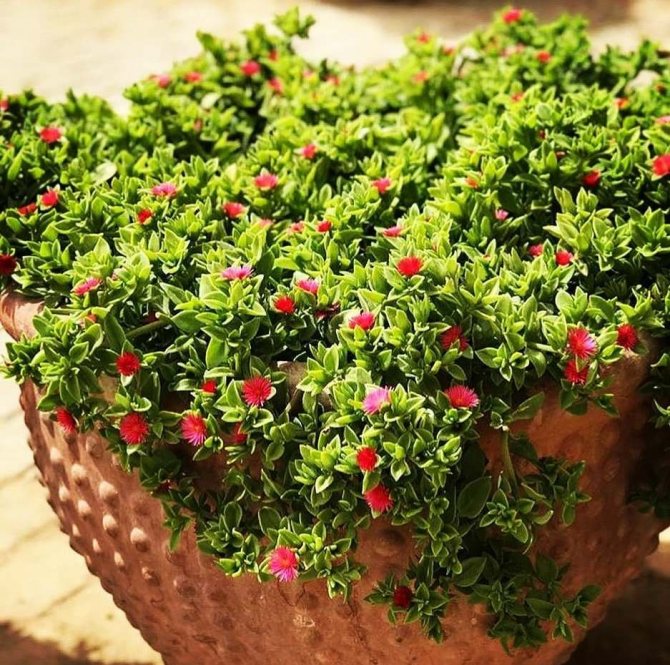

Aptenias love fresh air. @ Deskgram
Aptenia in the wild
Aptenia is a shrub that grows up to half a meter throughout the year. Its leaves are more than 5 centimeters long and about 3 centimeters wide. The papillae cover the leaf plates. The flowers do not form inflorescences and are planted on short stalks.
The aptenia fruit is a water-absorbing capsule with tiny seeds. It ripens in a couple of months. The plant blooms very luxuriantly, with bright small flowers, in areas well-lit by the sun.
In Africa and Australia, this plant calmly survives drought, but does not tolerate frost. This sun-loving flower needs warmth, so it can be classified as a heat-resistant plant.
In a natural area, for example, in the same Buenos Aires, aptenia blooms from early spring to almost winter.Flowers bloom usually at noon. But indoor plant analogues with different illumination open in the morning.
The most common aptenia is one-year, but it can be two-year and even long-term. However, its entire active period in the life cycle is about 4 months.
This flower is still little studied. Although it begins to bloom after saturation of all parts of the plant with salts in high concentration. This leads to aptenia to fruiting, after which the death of the annual occurs.
In Australia and California, this adaptable flower grows on depleted soil near landfills, along roads. The salty composition of the soil is important to him for the accumulation of moisture, so this plant can leach the earth, absorbing water-soluble salt from the soil and giving back insoluble dry salt.
It collects throughout the plant, collecting moisture. And salt also helps to create "crystal" skin. It is also noteworthy that the crystal aptenia inhibits the development of neighboring plants, throwing dry salt into the ground, from which the neighbors die. Since ancient times, Africans have included this plant in the composition of ritual drinks, because the juice of Aptenia is rich in psychotropic hallucinogens.
Views
Until now, aptenia remains a poorly studied plant. It is known that in nature its diversity is limited to 4 endemic South African species, of which only 2 are widespread - with cordate and lanceolate leaves.
In indoor floriculture, this succulent is represented by the following types:
- Aptenia is cordial. Creeping perennial with fleshy stems up to 60 cm long, which have many branches. Leaves are dense, bright green, about 2.5 cm long, arranged in pairs. The flowers are small, sitting in the axils of the leaves, mainly purple, crimson, sometimes lilac. Plant height does not exceed 25 cm.
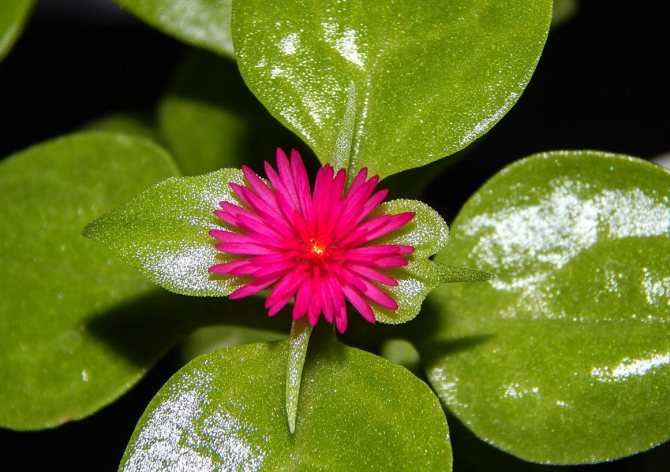

- Aptenia is lanceolate. This species is distinguished by an elongated shape of leaf plates and longer shoots of a grayish tint, reaching 80 cm. The plant is characterized by rapid growth and forms a continuous cover on the soil surface under natural conditions. The flowers are small (up to 2 cm), pinkish or lilac in color.
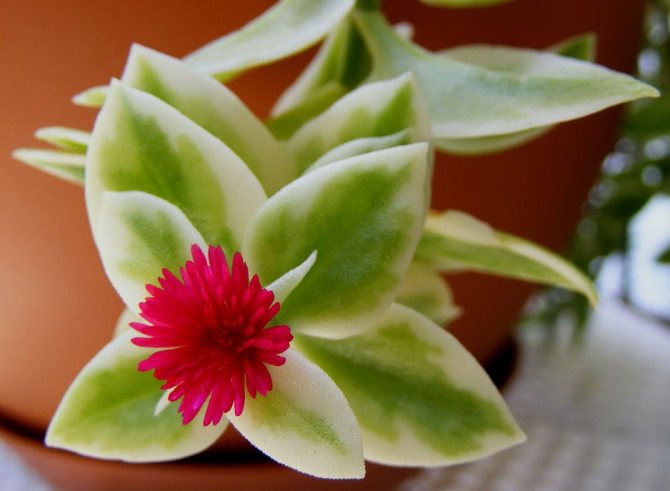

- Aptenia is variegated. This form is bred by breeders. The leaves are cordate, but smaller and lighter in color than in other species. There is a light edge along the edges of the plates, which makes the plant visually appear variegated.
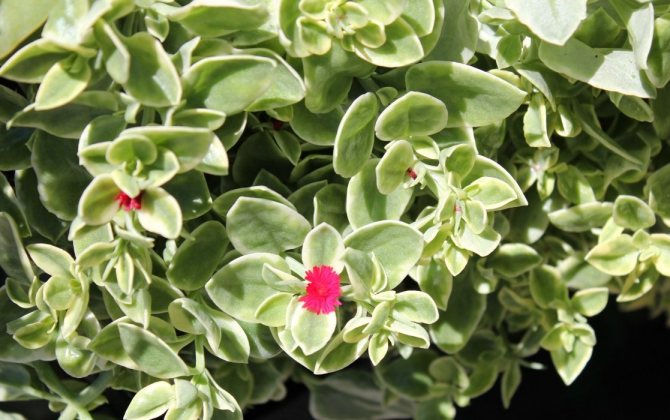

- Aptenia of Haeckal. This variety was named after the philosopher and explorer Ernest Haeckal, who described in his writings an unusual aptenia with beige or yellowish-white flowers.
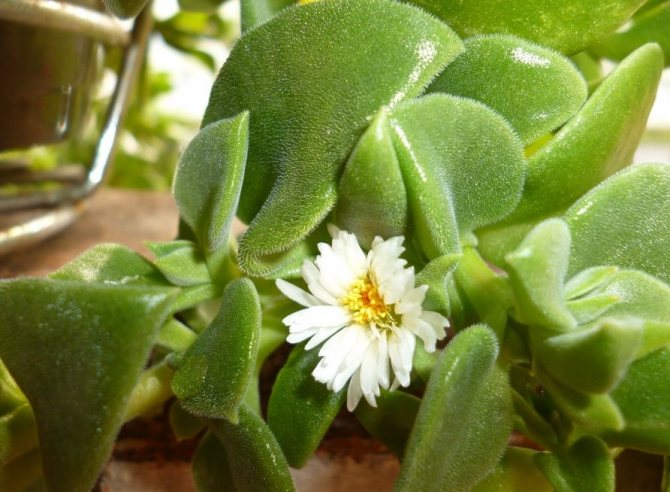

- Aptenia is white-flowered. Quite a rare species that can be seen in the Nikitsky Botanical Garden in Yalta. The flowers, as the name suggests, are white, composed of thin petals that curl in the middle, forming a loose and very delicate bud.
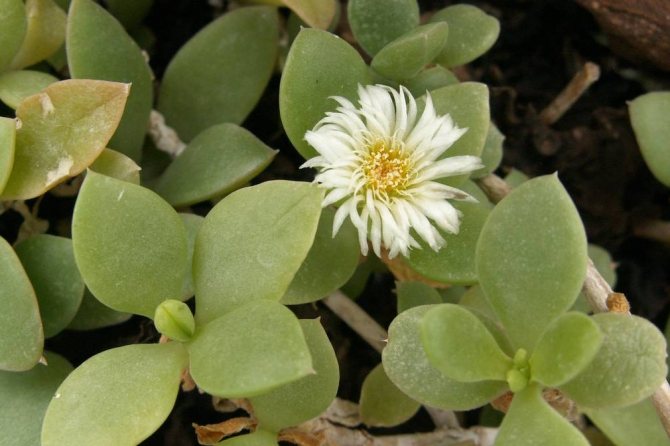

Frost resistance
In our country, the plant is sensitive to frost. Select a room where the temperature drops to 7 ° C at night. Residents of countries with a winter temperature of at least 7 ° C can leave the aptenia to overwinter in the ground. In mid-September, the aptenia is placed under a transparent rain protection. When the temperature approaches zero, the plant is pruned and covered with coniferous twigs. After freezing, the soil is covered with a layer of leaves and again with twigs. Until the end of the spring frost, the coating is not removed. It is worth leaving a few cuttings, keep the cuttings in the house during the winter. In spring, cuttings should be cut, leaving at least 2 green internodes on the plant. Pruned shoots are used as cuttings.
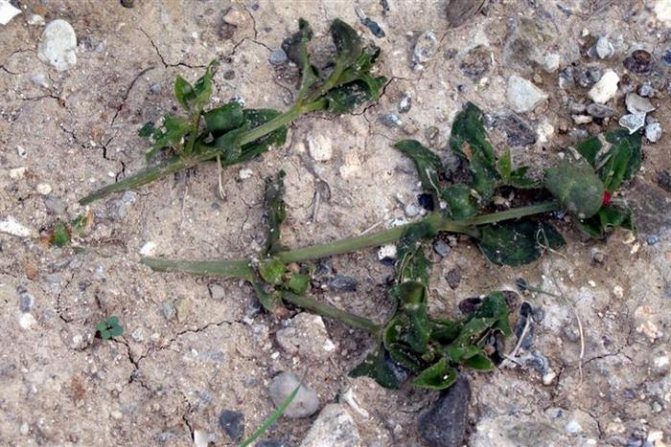

Transfer
It is worth replanting the aptenia flower only when the roots will no longer fit in the pot. It is advisable to transplant in the spring. Sod land can be mixed with sand 1: 1, charcoal and brick chips can be added to the mixture.
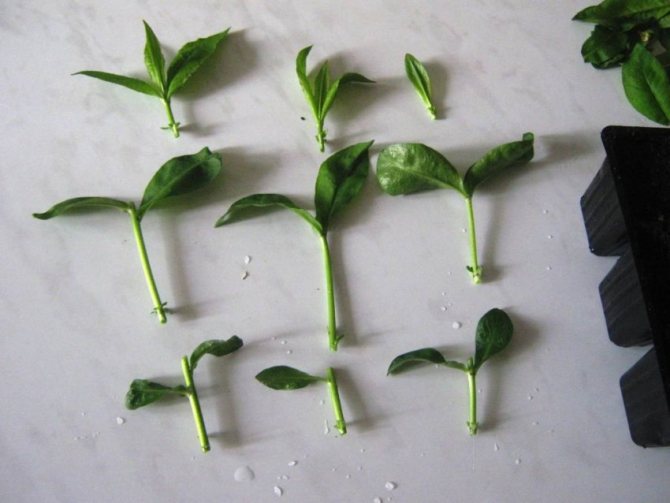

A prerequisite is the presence of drainage from pebbles or expanded clay. It is better to moisten the soil after transplanting after 3-5 days, depending on the size of the pot.
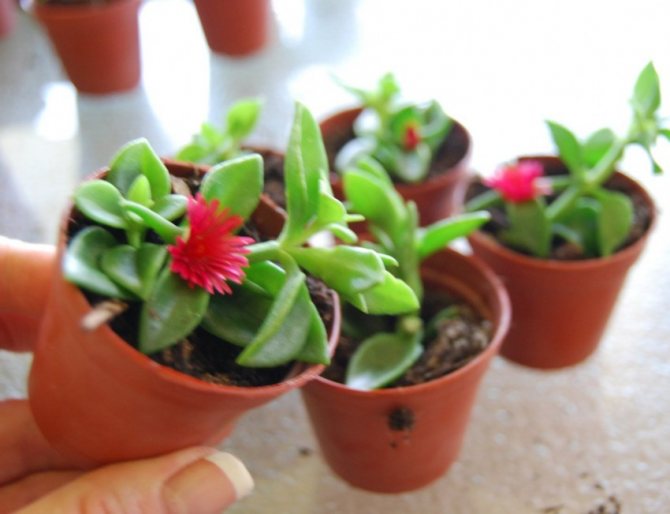

a brief description of
Aptenia shoots are dotted with fleshy leaves located opposite each other. The foliage is wedge-shaped with smooth edges, a bright, light green shade. The sprouts spread along the ground and can be up to one meter in length.
Aptenia blooms in large flowers with a diameter of 15 millimeters in different shades of red. After flowering, in place of the flowers, capsules are formed, filled with seeds, located in separate chambers.
The plant begins to bloom in April and pleases with its flowering until late autumn. In order for the flowering to be abundant and long-lasting, it is important to arrange rest periods for the aptenia so that it can rest and gain strength for the new growing season.
How the plant reproduces
Aptenia is propagated by seeds or cuttings. Both options are effective and bring results.
Propagation using cuttings
Cuttings are cut from the flower, then they are dried. To do this, they are folded into the shade. The resulting cuttings are rooted in water or sand. They are placed in a container, placed in a warm room with bright light. Cuttings are watered from time to time. In order for the roots to appear faster, the soil is enriched with heteroauxin. After that, the cuttings are planted in the soil.
Propagation using seeds
It is best to plant Aptenia seeds in sandy soil. To do this, they are distributed evenly over the soil. For early germination, planting in a greenhouse is used. The seeds of the plant sprout quickly and germinate through the sand. Seedlings are kept in a bright and warm room. From time to time they should be watered without flooding. Plants should be planted in cups as the seedlings gain growth with cytokinin paste. This usually happens one month after sowing. In the future, you can choose wide, low containers for young plants.
Popular: Growing citrus-scented pereskia succulent
Now read:
- How Chinese cabbage is grown outdoors
- Varieties, planting and care of perennial rudbeckia
- Flowering of a capricious oncidium, after a neat transplant
- Restoration and stimulation of orchid flowering with succinic acid
About
Leading Researcher of the Laboratory of Vegetable and Berry Crops, Yakutsk Research Institute of Agriculture, Siberian Branch of the Russian Academy of Agricultural Sciences, Republic of Sakha (Yakutia).
A little about the plant
This houseplant is evergreen and belongs to the genus Aizaceae. It is considered a succulent. Aptenia has several names, which in translation sound like "wingless" or "flower that dissolves at noon."
The flower has fleshy, creeping stems with heart-shaped leaves. The leaves are as fleshy as the stem. The flowers of the plant are small and "hidden" in the leaf axils. They bloom in bright daylight. Inflorescences are bright purple in color.
This plant has been little studied by botanists and scientists. As salt accumulates in the plant, aptenia gains color. The plant is annual, so its development cycle is short. The sprout is gaining growth, begins to bloom, a fruit with seeds is formed and withers.
Aptenia is best grown in salt-rich soil. All salts that are considered soluble are absorbed by the plant, and insoluble compounds are returned to the soil. This feature of the plant can negatively affect other species growing nearby.
Care
After purchasing a plant, you should check the condition of the roots. A flower pot is taken at least 8 cm high or a hanging basket. The diameter of the pot is adjusted to the size of the plant or the number of seedlings. The soil should resemble natural - permeable, rocky, sufficiently nutritious.Soil for cacti or self-prepared soil without peat is suitable: 1 part of the earth, 1 part of 2-year-old compost and 1 part of gravel with the smallest grain, without adding fertilizers. Aptenia responds poorly to excess nutrients with a lack of flowering. A drainage layer is required at the bottom of the pot.
Aptenia cordifolia tolerates light dehydration and occasional high humidity (without standing water at the roots) relatively easily. Watering with standing tap water, when all the chlorine comes out, the water temperature will be close to the temperature of the earth. By watering the substrate directly from the tap, the substrate is greatly cooled, stressing the African plant.
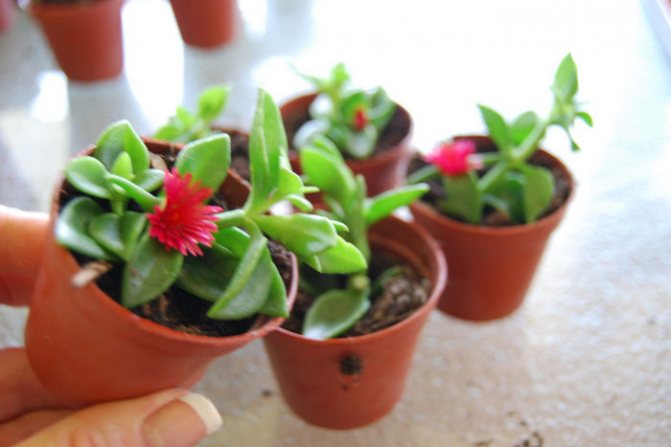

In winter, it is worth providing a lot of light and a lower temperature. Since most do not have free southern windowsills, not to mention winter gardens, we resort to storing small plants. In August, seedlings are taken, rooted as pelargonium. The seedlings are smaller, easier to place in a good location.
Aptenia cordifolia
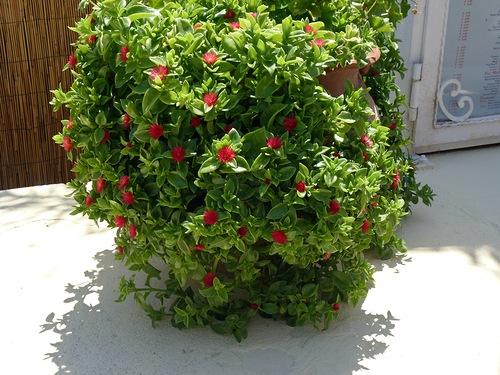

The most common in our area is the creeping cordial aptenia. Its decorative effect makes the plant very expressive in hanging pots. The stems of the plant, similar to thin hoses, hang by 25-30 centimeters.
The leaves of this species are small, only about one and a half centimeters long. They are located oppositely on the stem, have an inverted ovoid shape.
Aptenia blooms are shallow, deep pink and even scarlet. Flowers are knocked out of the axils of leaves in the morning, open all day, and die off closer to night. The flower is no more than one and a half centimeters wide.
It is noteworthy that the plant itself has adapted to escape from sunburn in the sultry African savannah, however, as well as from excessive evaporation. For this, "crystal" cells develop in the tissues of this aptenia, forming a protective film that reflects dangerous rays and absorbs only the useful part of the radiation.
Breeders have developed a hybrid flower shape in different shades of red. And the color of the leaves is formed from the transitions of various shades - from greenish to brown.
Such hybrids, obtained by crossing different species, are very demanding on the soil. They develop best in light, aero- and permeable soils.
When flowering is complete, this insect-pollinated plant forms an angiosperm capsule of four nests. Small poppies do not exceed 1 centimeter in length. It is not strange that its small seeds fall out of the cocoon as dust and multiply quite easily. Moreover, even fresh, only harvested seeds germinate.
There are many subspecies of this popular aizoon plant. Aptenia grows in the dry part of Africa, although it is also found in other regions.
There are many other types of aptenia. But they are less popular in our area due to their inability to adapt to the peculiarities of the climate.
Application
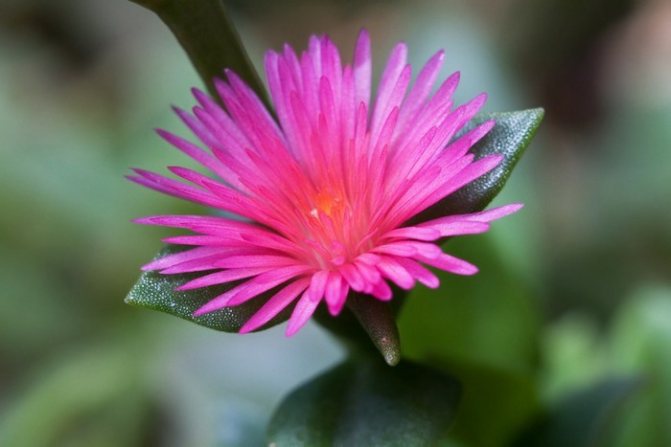

Aptenia hearty, due to its drooping cut, is perfect for any hanging containers from baskets to balcony boxes or pots set on high pedestals. In the garden, you can plant dry places and all sorts of retaining walls.
Aptenia in Africa has long been used as an anti-inflammatory agent, more often used for compresses. Like a gentle enema for newborns. Burned leaves and stems are used for joint pain. The plant is a symbol of love and magical practices associated with this feeling, something like lovage in our country.
Description
Natural habitat in South Africa. Height, it is difficult to determine the height of creepers. Grown in pots of medium height up to 10 cm, the length of the shoots is about 60 cm. Flowering, if the spring is warm and sunny, blooms in late May, blooms with the growth of shoots until September. The color of the flowers, the species has a light purple color.However, hybrids have shades of pink, red, carmine purple. A place that bears the midday sun. In the absence of light, internodes lengthen, aptenia loses its attractive appearance, does not bloom.
